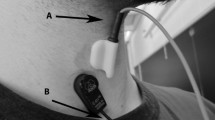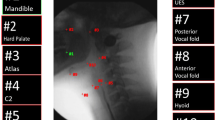Abstract
Swallowing accelerometry has been proposed as a potential minimally invasive tool for collecting assessment information about swallowing. The first step toward using sounds and signals for dysphagia detection involves characterizing the healthy swallow. The purpose of this article is to explore systematic variations in swallowing accelerometry signals that can be attributed to demographic factors (such as participant gender and age) and anthropometric factors (such as weight and height). Data from 50 healthy participants (25 women and 25 men), ranging in age from 18 to 80 years and with approximately equal distribution across four age groups (18-35, 36-50, 51-65, 66 and older) were analyzed. Anthropometric and demographic variables of interest included participant age, gender, weight, height, body fat percent, neck circumference, and mandibular length. Dual-axis (superior-inferior and anterior-posterior) swallowing accelerometry signals were obtained for five saliva and five water swallows per participant. Several swallowing signal characteristics were derived for each swallowing task, including variance, amplitude distribution skewness, amplitude distribution kurtosis, signal memory, total signal energy, peak energy scale, and peak amplitude. Canonical correlation analysis was performed between the anthropometric/demographic variables and swallowing signal characteristics. No significant linear relationships were identified for saliva swallows or for superior-inferior axis accelerometry signals on water swallows. In the anterior-posterior axis, signal amplitude distribution kurtosis and signal memory were significantly correlated with age (r = 0.52, P = 0.047). These findings suggest that swallowing accelerometry signals may have task-specific associations with demographic (but not anthropometric) factors. Given the limited sample size, our results should be interpreted with caution and replication studies with larger sample sizes are warranted.



Similar content being viewed by others
References
Vice F, Bosma J, Cervical auscultation of feeding in adults. Video available from the University of Maryland School of Medicine (undated).
Cichero JA, Murdoch BE. Detection of swallowing sounds: methodology revisited. Dysphagia. 2002;17:40–9. doi:10.1007/s00455-001-0100-x.
Hamlet S, Penney DG, Formolo J. Stethoscope acoustics and cervical auscultation of swallowing. Dysphagia. 1994;9:63–8. doi:10.1007/BF00262761.
Takahashi K, Groher ME, Michi K. Methodology for detecting swallowing sounds. Dysphagia. 1994;9:54–62.
Takahashi K, Groher ME, Michi K. Symmetry and reproducibility of swallowing sounds. Dysphagia. 1994;9:168–73. doi:10.1007/BF00341261.
Joshi AM, Reddy NP, Rane M, Canilang EP, Casterline J, Candadai RS. Biomechanical measurement of the swallowing reflex. J Biomech. 1989;22:1031. doi:10.1016/0021-9290(89)90304-7.
Reddy NP, Katakam A, Gupta V, Unnikrishnan R, Narayanan J, Canilang EP. Measurements of acceleration during videofluorographic evaluation of dysphagic patients. Med Eng Phys. 2000;22:405–12. doi:10.1016/S1350-4533(00)00047-3.
Reddy NP, Thomas R, Canilang EP, Casterline J. Toward classification of dysphagic patients using biomechanical measurements. J Rehabil Res Dev. 1994;31:335–44.
Reddy N, Canilang E, Casterline J, Rane M, Joshi A, Thomas R, et al. Noninvasive acceleration measurements to characterize the pharyngeal phase of swallowing. J Biomed Eng. 1991;13:379–83. doi:10.1016/0141-5425(91)90018-3.
Selley WG, Ellis RE, Flack FC, Bayliss CR, Pearce VR. The synchronization of respiration and swallow sounds with videofluoroscopy during swallowing. Dysphagia. 1994;9:162–7. doi:10.1007/BF00341260.
Leslie P, Drinnan MJ, Zammit-Maempel I, Coyle JL, Ford GA, Wilson JA. Cervical auscultation synchronized with images from endoscopy swallow evaluations. Dysphagia. 2007;22:290–8. doi:10.1007/s00455-007-9084-5.
Boiron M, Rouleau P, Metman EH. Exploration of pharyngeal swallowing by audio signal recording. Dysphagia. 1997;12:86–92. doi:10.1007/PL00009524.
Perlman AL, Ettema SL, Barkmeier J. Respiratory and acoustic signals associated with bolus passage during swallowing. Dysphagia. 2000;15:89–94.
Cichero JA, Murdoch BE. The physiologic cause of swallowing sounds: answers from heart sounds and vocal tract acoustics. Dysphagia. 1998;13:39–52. doi:10.1007/PL00009548.
Cichero JA, Murdoch BE. What happens after the swallow? Introducing the glottal release sound. J Med Speech-Lang Pathol. 2003;11:34–41.
Moriniere S, Beutter P, Boiron M. Sound component duration of healthy human pharyngoesophageal swallowing: a gender comparison study. Dysphagia. 2006;21:175–82. doi:10.1007/s00455-006-9023-x.
Borr C, Hielscher-Fastabend M, Lucking A. Reliability and validity of cervical auscultation. Dysphagia. 2007;22:225–34. doi:10.1007/s00455-007-9078-3.
Leslie P, Drinnan MJ, Finn P, Ford GA, Wilson JA. Reliability and validity of cervical auscultation: a controlled comparison using videofluoroscopy. Dysphagia. 2004;19:231–40.
Cichero JA, Murdoch BE. Acoustic signature of the normal swallow: characterization by age, gender, and bolus volume. Ann Otol Rhinol Laryngol. 2002;111:623–32.
Youmans SR, Stierwalt JA. An acoustic profile of normal swallowing. Dysphagia. 2005;20:195–209. doi:10.1007/s00455-005-0013-1.
Kent RD. Phonetics acoustic. In: Kent RD, editor. The Speech Sciences. San Diego: Singular Publishing; 1997. p. 329–67.
Lee J, Steele CM, Chau T. Time and time-frequency characterization of dual-axis swallowing accelerometry signals. Physiol Meas. 2008;29:1105–20. doi:10.1088/0967-3334/29/9/008.
Sejdić E, Steele CM, Chau T. Segmentation of dual-axis swallowing accelerometry signals in healthy subjects with analysis of anthropometric effects on duration of swallowing activities. IEEE Trans Biomed Eng. 2009;56(4):1090–7.
Sejdic E, Komisar V, Steele CM, Chau T. An investigation of baseline characteristics of dual-axis swallowing accelerometry characteristics. IEEE Trans Biomed Eng. 2009 (submitted).
Huckabee M, Garcia M, Barofsky I. SEMG measurement of the head and neck: applications to dysphagia rehabilitation. Dysphagia. 1996;11:165–8. doi:10.1007/BF00417909. [abstract].
Evetovich T, Housh T, Johnson G, Smith D, Ebersole K, Perry S. Gender comparisons of the mechanomyographic responses to maximal concentric and eccentric isokinetic muscle actions. Med Sci Sports Exerc. 1998;30:1697–702. doi:10.1097/00005768-199812000-00007.
Nonaka H, Mita K, Akataki K, Watakabe M, Itoh Y. Sex differences in mechanomyographic responses to voluntary isometric contractions. Med Sci Sports Exerc. 2006;38:1311–6. doi:10.1249/01.mss.0000227317.31470.16.
Kidd D, Lawson J, Nesbitt R, MacMahon J. Aspiration in acute stroke: a clinical study with videofluoroscopy. Q J Med. 1993;86:825–9.
Martino R, Pron G, Diamant NE. Screening for oropharyngeal dysphagia in stroke: insufficient evidence for guidelines. Dysphagia. 2000;15:19–30.
Mari F, Matei M, Ceravolo MG, Pisani A, Montesi A, Provinciali L. Predictive value of clinical indices in detecting aspiration in patients with neurological disorders. J Neurol Neurosurg Psychiatry. 1997;63:456–60. doi:10.1136/jnnp.63.4.456.
Logemann JA, Veis S, Colangelo L. A screening procedure for oropharyngeal dysphagia. Dysphagia. 1999;14:44–51. doi:10.1007/PL00009583.
Daniels SK, Ballo LA, Mahoney MC, Foundas AL. Clinical predictors of dysphagia and aspiration risk: outcome measures in acute stroke patients. Arch Phys Med Rehabil. 2000;81:1030–3. doi:10.1053/apmr.2000.6301.
Donoho DL. De-noising by soft-thresholding. IEEE Trans Inf Theory. 1995;41:613–27. doi:10.1109/18.382009.
Lee J, Blain S, Casas M, Kenny D, Berall G, Chau T. A radial basis classifier for the automatic detection of aspiration in children with dysphagia. J Neuroeng Rehabil. 2006;3:14–31. doi:10.1186/1743-0003-3-14.
Abdelmonem AA, Clark V, May S. Computer aided multi-variate analysis. New York: CRC Press; 2004.
Hardoon DR, Szedmak S, Shawe-Taylor J. Canonical correlation analysis: an overview with application to learning methods. Southampton, UK: Image, Speech and Intelligent Systems Research Group, School of Electronics and Computer Science, University of Southampton, 2004.
Kelly L, Manly BFJ. Multivariate statistical methods: a primer. 3rd ed. New York: CRC Press; 2004.
Stevens JP. Applied multivariate statistics for the social sciences. 4th ed. Mahwah, NJ: Lawrence Erlbaum Associates; 2002.
Feinstein AR. Principles of medical statistics. Boca Raton, FL: Chapman & Hall; 2002.
Smeitink E, Dekker R. A simple approximation to the renewal function. IEEE Trans Reliab. 1990;39:71–5. doi:10.1109/24.52614.
Sugiyama T, Ushizawa K. Power of largest root on canonical correlation. Commun Stat. 1992;21:947–60.
Hiss SG, Treole K, Stuart A. Effects of age, gender, bolus volume, and trial on swallowing apnea duration and swallow/respiratory phase relationships of normal adults. Dysphagia. 2001;16:128–35. doi:10.1007/s004550011001.
Moriniere S, Boiron M, Alison D, Makris P, Beutter P. Origin of the sound components during pharyngeal swallowing in normal subjects. Dysphagia. 2008;23:267–73. doi:10.1007/s00455-007-9134-z.
Kim Y, McCullough GH. Maximal hyoid displacement in normal swallowing. Dysphagia. 2008;23:274–9. doi:10.1007/s00455-007-9135-y.
Chi-Fishman G, Sonies BC. Effects of systematic bolus viscosity and volume changes on hyoid movement kinematics. Dysphagia. 2002;17:278–87. doi:10.1007/s00455-002-0070-7.
Ishida R, Palmer JB, Hiiemae KM. Hyoid motion during swallowing: factors affecting forward and upward displacement. Dysphagia. 2002;17:262–72. doi:10.1007/s00455-002-0064-5.
Kendall KA, Leonard RJ. Hyoid movement during swallowing in older patients with dysphagia. Arch Otolaryngol Head Neck Surg. 2001;127:1224–9.
Perlman AL, Vandaele DJ, Otterbacher MS. Quantitative assessment of hyoid bone displacement from video images during swallowing. J Speech Hear Res. 1995;38:579–85.
Mendoza JL, Markos VH, Gonter R. A new perspective on sequential testing procedures in canonical analysis: a Monte Carlo evaluation. Multivariate Behav Res. 1978;13:371–82. doi:10.1207/s15327906mbr1303_8.
Acknowledgments
The authors are grateful to the Ontario Science Centre Payload Science Program and to Dr. Ervin Sejdic, Erin Yeates, Anna Ammoury, Joon Lee, Kadeen Johns, Julie Chan, and Katherine Chow for assistance with data collection and analysis. This research was supported by funding from an Ontario Centres of Excellence Proof of Principle Grant, Panacis Medical, and the Toronto Rehabilitation Institute. The authors acknowledge the support of the Toronto Rehabilitation Institute which receives funding under the Provincial Rehabilitation Research Program from the Ministry of Health and Long-term Care in Ontario. The views expressed do not necessarily reflect those of the ministry.
Author information
Authors and Affiliations
Corresponding author
Glossary
- Daubechies Wavelet
-
A family of orthogonal wavelets often used to generate a time-frequency representation of physiologic and biomechanical signals.
- Frequency at Peak Intensity
-
(used by Cichero and Murdoch [19]): The peak frequency at the point of the peak intensity (FPI), measured in Hz, was defined as the highest frequency at the point of highest intensity and was obtained directly from the sound spectrogram.
- Frequency Range
-
(used by Cichero and Murdoch [19]): The highest frequency of an acoustic signal, in Hz, obtained directly from a sound spectrogram.
- Kurtosis
-
A measure of the “peakedness” of the probability distribution of a variable (in the case of this article, of the accelerometry signal’s amplitude distribution).
- Peak Frequency
-
The frequency of the “loudest sound,” in Hz.
- Peak Intensity
-
(used by Cichero and Murdoch [19]): The point of highest displacement of an acoustic signal on an energy contour (5-ms frame length, no smoothing), recorded in decibels (dB).
- Scale
-
Generally, the “frequency” dimension of a wavelet transform. In this article, scale is the level of the discrete wavelet transform of the signal bearing the highest fraction of the signal energy.
- Signal Memory
-
The lag at which the autocorrelation of the signal decays to 1/e of its maximum.
- Skewness
-
A measure of the asymmetry of the probability distribution of a variable.
- Variance
-
A measure of statistical dispersion, averaging the squared distance of a variable’s possible values from the mean.
- Wavelet Transform
-
A wavelet is a mathematical function used to divide a signal into different scale and time components. A wavelet transform generates a multiresolution time-frequency representation of a signal. Wavelet transforms have advantages over traditional Fourier transforms for representing functions that have discontinuities and sharp peaks, and for accurately deconstructing and reconstructing finite, nonperiodic, and/or nonstationary signals.
Rights and permissions
About this article
Cite this article
Hanna, F., Molfenter, S.M., Cliffe, R.E. et al. Anthropometric and Demographic Correlates of Dual-Axis Swallowing Accelerometry Signal Characteristics: A Canonical Correlation Analysis. Dysphagia 25, 94–103 (2010). https://doi.org/10.1007/s00455-009-9229-9
Received:
Accepted:
Published:
Issue Date:
DOI: https://doi.org/10.1007/s00455-009-9229-9




